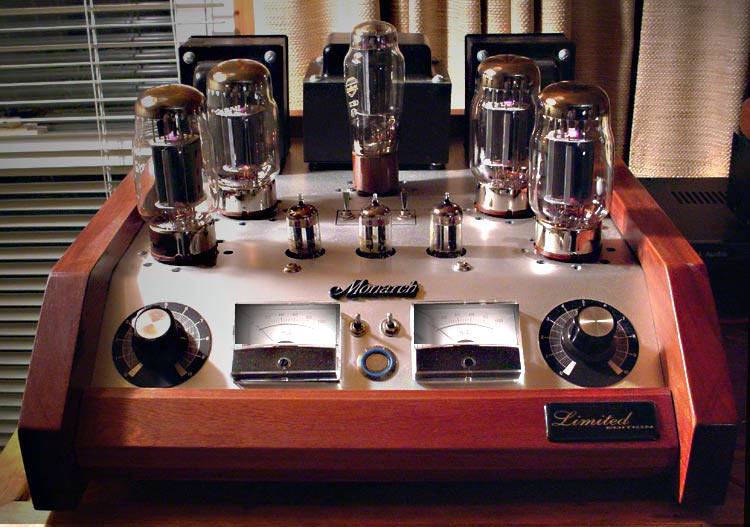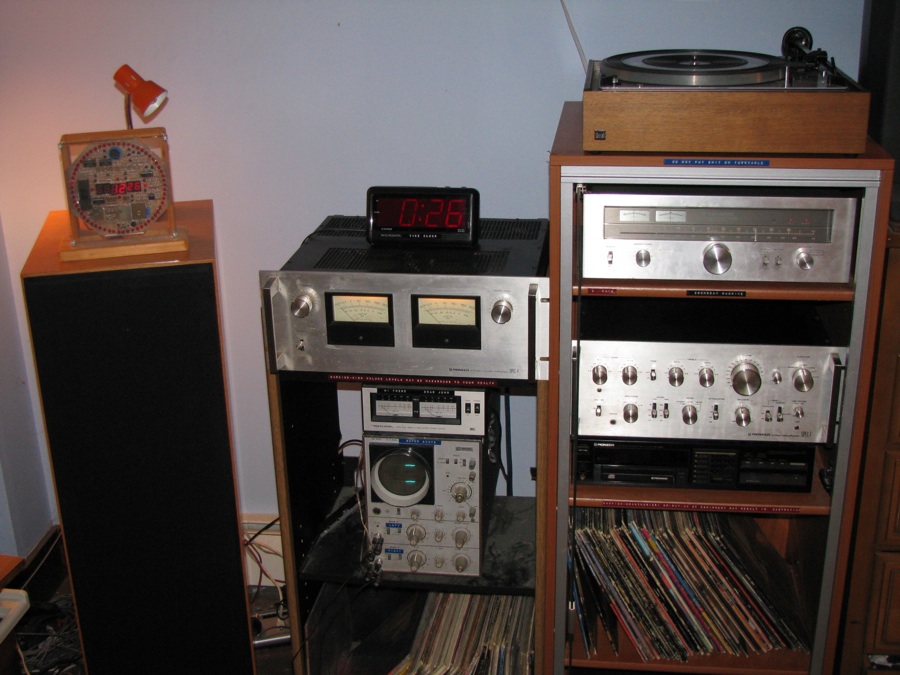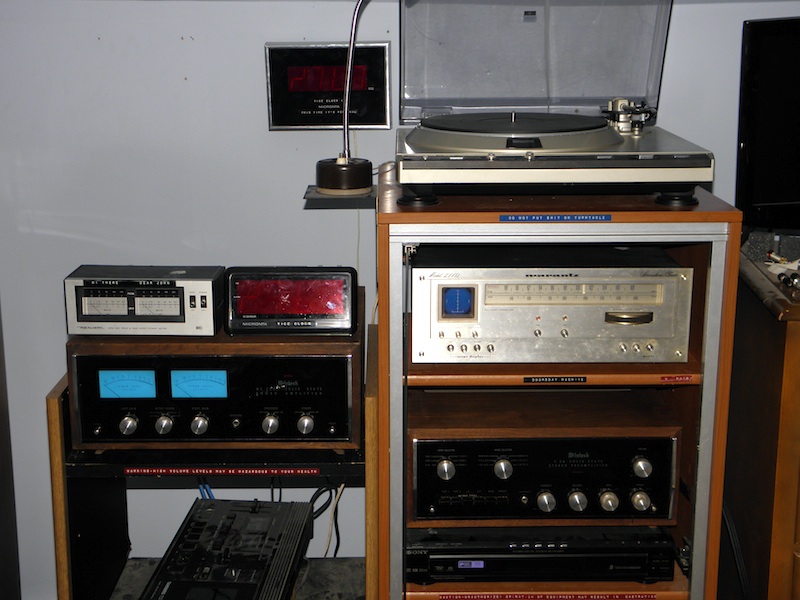You are using an out of date browser. It may not display this or other websites correctly.
You should upgrade or use an alternative browser.
You should upgrade or use an alternative browser.
You Know What I Never Understood About Those Amps with VU Meters?
- Thread starter AnzacSonata
- Start date
twiiii
Lunatic Member
If you want accurate meters you want Mcintosh or maybe Accuphase. $$$$. Mac meters are over 95% accurate up to 2000 HZ. I Prefer the older meters that are just a little less accurate . Like the ones on my 2505. But you have to hassle the range switch. My MPI-4 electronic vertical columns are the most accurate, but here again you need the range switch. At least new Mac meters have 60 db dynamic range which is good for most of us. I listen at 2 watt levels for Forte passages most of the time so that gives me a 23 db peak margin and 40 db range for quiet passages. I will admit whispering the meters don't register. Of course showing such a wide range with pop music being compressed their isn't much needle action. But with classical music its not unusual to see over 40 db swings repeated ly. I like the horizontal led's on my Nakamichi cassette and Marantz CD recorders. I bought. electronic meters for my reel to reels as professional meters lie up to 18 db due to the ballistics of the meter mechanisms. MY 300-4 used two 354 electronics had small METERS. I had to detune the meters by 6 db to get the same levels on the tape as I did with 351 electronics with the big meters on the 300-2. .Remember in the old days maintaining or achieving good signal to noise was very very important. Can you imagine living with phono sections with only 64 db signal to noise and a tape machine with less.
Last edited:
sKiZo
Hates received: 92644 43.20°N 85.50°W
Big meters are "nice" but having the ability to shut them off when you feel like it is a plus.
When that feature is built in you know someone was on the ball.
So I get bonus points for putting a center off on my custom build's bias meters? Kewl!

bowtie427ss
Lunatic Member
The most accurate meters on an amplifier do not measure watts at all, they measure db below full power.
In order to measure watts accurately, the meters on any given amplifier would have to be calculated precisely to the impedance of the loudspeaker. Since the impedance of most dynamic loudspeakers varies to a degree with frequency, the scale of the meters would only be accurate at the frequencies where the impedance was equal to the calibration reference.
There are instances where a watt scale could be fairly accurate, but those are exceptions not the rule. Maggies(Magnepan) would be one example with their nearly purely resistive load and nearly ruler flat impedance curve. Very few loudspeakers present a load similar to the Maggies, i might be inclined to call them the perfect load from the amplifier's perspective.
In order to measure watts accurately, the meters on any given amplifier would have to be calculated precisely to the impedance of the loudspeaker. Since the impedance of most dynamic loudspeakers varies to a degree with frequency, the scale of the meters would only be accurate at the frequencies where the impedance was equal to the calibration reference.
There are instances where a watt scale could be fairly accurate, but those are exceptions not the rule. Maggies(Magnepan) would be one example with their nearly purely resistive load and nearly ruler flat impedance curve. Very few loudspeakers present a load similar to the Maggies, i might be inclined to call them the perfect load from the amplifier's perspective.
If an amp has them, that is cool. If an amp does not have them, then I still buy it if I like it. Sometimes meters catch my eye like on the Fisher I bought a few weeks ago. I dont usually give early 80s Fisher a second look but this one was so damn nice looking that I researched it (mainly on AK) and it turns out it is a pretty nice amp. In our dark bedroom at night it is a handsome unit that sounds pretty nice as well.


Agreed. When I listened to a pair of Mac 2301s at a reviewer friend’s house, I switched the cyclops eyes off.Big meters are "nice" but having the ability to shut them off when you feel like it is a plus.
I'm not sure I follow. Impedance includes reactive and resistive loads so the voltage the amp needs to drive the current pulled by that load will yield the true watts at that instant. Yes?The most accurate meters on an amplifier do not measure watts at all, they measure db below full power.
In order to measure watts accurately, the meters on any given amplifier would have to be calculated precisely to the impedance of the loudspeaker. Since the impedance of most dynamic loudspeakers varies to a degree with frequency, the scale of the meters would only be accurate at the frequencies where the impedance was equal to the calibration reference.
There are instances where a watt scale could be fairly accurate, but those are exceptions not the rule. Maggies(Magnepan) would be one example with their nearly purely resistive load and nearly ruler flat impedance curve. Very few loudspeakers present a load similar to the Maggies, i might be inclined to call them the perfect load from the amplifier's perspective.
I LIKE MUSIC
Super Member
Last edited:
I really like meters. I don't know of their accuracy, or whatnot, but I like them.
Did I read that right.....temporary power from the M-510 can hit 2.4kw!!!!??? PER CHANNEL????



Did I read that right.....temporary power from the M-510 can hit 2.4kw!!!!??? PER CHANNEL????


Yes I agree and understand power factor but that difference applies to calculating true watts, not directly metering them. When you meter kW directly or with PT's and CT's the meter reads true watts. There's no adjustment for apparent power. When I was designing 5 mVA industrial cogen systems we'd use a synchronous generator with a leading power factor and sell kVARs to the utility which was metered with a kVAR meter of the same PT's and CT's.For a reactive load the voltage and current will not be in phase. Power will not be voltage x current = watts. It will be VA (volt amps).
This is called the power factor.
View attachment 1284922
Voltage times current in a reactive load gives apparent power not real power.
View attachment 1284926
Real power will be less.
Last edited:
I LIKE MUSIC
Super Member
IIRC, the utility (electric) meter measures the integral of the voltage times the current, so it measures only real energy delivered., so they measure real energy (watts) delivered to the load over time so there is a correction for reactive loads. If one was to look at just the current and voltage at any given time and the load was reactive, it would be apparent power not real power and it would not be the same.
There is no way to get around the impact of the phase angle as you know.
For those that may not know, KVAR = Kilo Volt Ampere Reactive.
The picture below shows what happens. Note that this is for a purely inductive load, just for example.

A voltmeter and amp meter will measure the values where I have highlighted the wave forms (because by themselves they can't take into account the phase angle, because they happen at different times [different phase]), giving apparent power (voltage times current) in a reactive load. The real power is where the two wave forms cross and since the value of the voltage and current is less there (as can be seen in the picture) the power is less what the voltmeter and amp meter would indicate.
The real power will continue to increase as the the voltage and current become closer to being in phase, then the power will equal voltage times current.
It is just that pesky phase angle...
There is no way to get around the impact of the phase angle as you know.
For those that may not know, KVAR = Kilo Volt Ampere Reactive.
I'm not sure I follow. Impedance includes reactive and resistive loads so the voltage the amp needs to drive the current pulled by that load will yield the true watts at that instant. Yes?
The picture below shows what happens. Note that this is for a purely inductive load, just for example.

A voltmeter and amp meter will measure the values where I have highlighted the wave forms (because by themselves they can't take into account the phase angle, because they happen at different times [different phase]), giving apparent power (voltage times current) in a reactive load. The real power is where the two wave forms cross and since the value of the voltage and current is less there (as can be seen in the picture) the power is less what the voltmeter and amp meter would indicate.
The real power will continue to increase as the the voltage and current become closer to being in phase, then the power will equal voltage times current.
It is just that pesky phase angle...
Last edited:
damacman
Resident Psycho
Nice. I still have two. In '94 I bought one out of The Wrangler in Little Rock. It powered (4) EV 18s on the dance floor.One of the places I was a nightclub DJ had, for power a Mac 2300. I remember the 8 JBL 4312's they had above their tiny dance floor. Halloween was lots of fun as I played Edgar Winters "Frankenstein" and during the drum and electronics part, I would play Pink Floyds DSOTM heartbeat, and crank it up until it was a little louder than Frankenstein. Those meters would peg!
While I also have numerous Mc amps with Watt Meters, I prefer the VU meters of the MC2300.
damacman
Resident Psycho
I tend to agree with this as well.The most accurate meters on an amplifier do not measure watts at all, they measure db below full power.
In order to measure watts accurately, the meters on any given amplifier would have to be calculated precisely to the impedance of the loudspeaker. Since the impedance of most dynamic loudspeakers varies to a degree with frequency, the scale of the meters would only be accurate at the frequencies where the impedance was equal to the calibration reference.
There are instances where a watt scale could be fairly accurate, but those are exceptions not the rule. Maggies(Magnepan) would be one example with their nearly purely resistive load and nearly ruler flat impedance curve. Very few loudspeakers present a load similar to the Maggies, i might be inclined to call them the perfect load from the amplifier's perspective.
Yep, Radio Shack did the same thing with their Realistic APM-200 outboard wattmeters. Analog meters for RMS watts, and LEDs for peak watts. Switchable ranges for 2W and 200W readings (I generally leave mine set to 2W). Using the APM-200 showed me that the meters on my Pioneer SPEC-4 read out in peak watts:There was a transition in the late 70's when Meters and LED's were used together, best of both worlds
for those seeking bling and accurate indications.
One well executed example being the Luxman M-6000 and M-4000.
View attachment 1283691

And here they are helping me check the readout of the meters on my McIntosh MC2505:

As other's have stated in this thread, most of the amps you have enjoyed for decades with meters on the front panel are simply volt meters, not ammeters. For virtually all, (and there are exceptions) they are simply calibrated at some given frequency input (generally 1kHz) at some given fixed voltage reference, and span is set at no load at the outputs. Some have compensation settings for various impedance loads, some do not. What does 100 watts sound like? Depends. What's the impedance and sensitivity of the load? (moral of this story is this, your meters are simply a general reference voltage level) The rest is just fluff since total impedance of a speaker is frequency dependent too, you'll be trying to nail Jello to a wall. The remainder of the arguments are simply silliness, that have no real world application.
Last edited:
charles 1973
Super Member
I have only seen one lab accurate audio power meter and it wasn't on an expensive amp. It was on an audio selection control panel in an audio store.
The technician said it takes into account every variable. He said this type of meter is WAY to expensive and complex to be included in all but the most expensive amps, and even then would be rare. It was the only meter I've seen that showed the actual realationship between peak and average RMS power. Peaks on some music we listened to reached 50w, While the RMS average was in the to 4 -5w range.
The technician said it takes into account every variable. He said this type of meter is WAY to expensive and complex to be included in all but the most expensive amps, and even then would be rare. It was the only meter I've seen that showed the actual realationship between peak and average RMS power. Peaks on some music we listened to reached 50w, While the RMS average was in the to 4 -5w range.



